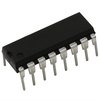-
Part Symbol
-
Footprint
-
3D Model
Available Download Formats
By downloading CAD models, you agree to our Terms & Conditions and Privacy Policy

1.5 A Switching Regulator
Tip: Data for a part may vary between manufacturers. You can filter for manufacturers on the top of the page next to the part image and part number.
L4962/A by STMicroelectronics is a Switching Regulator or Controller.
Switching Regulator or Controllers are under the broader part category of Power Circuits.
A power circuit delivers electricity in order to operate a load for an electronic device. Power circuits include transformers, generators and switches. Read more about Power Circuits on our Power Circuits part category page.
| Part # | Distributor | Description | Stock | Price | Buy | |
|---|---|---|---|---|---|---|
|
DISTI #
70389993
|
RS | L4962/A Step-Down Switching Regulator Adjustable, 5.1 - 40 V, 16-Pin PDIP Min Qty: 10 Package Multiple: 1 Container: Bulk | 0 |
|
$1.8900 / $1.9200 | RFQ |
|
|
NexGen Digital | 38 |
|
RFQ | ||
|
DISTI #
L4962/A
|
Avnet Silica | Conv DCDC Single Step Down 9V to 46V 16Pin Power PDIP (Alt: L4962/A) RoHS: Compliant Min Qty: 25 Package Multiple: 25 Lead time: 143 Weeks, 0 Days | Silica - 0 |
|
Buy Now | |
|
DISTI #
L4962/A
|
EBV Elektronik | Conv DCDC Single Step Down 9V to 46V 16Pin Power PDIP (Alt: L4962/A) RoHS: Compliant Min Qty: 25 Package Multiple: 25 Lead time: 143 Weeks, 0 Days | EBV - 0 |
|
Buy Now | |
|
|
Vyrian | Other Function Semiconductors | 528 |
|
RFQ |
By downloading CAD models, you agree to our Terms & Conditions and Privacy Policy
|
|
L4962/A
STMicroelectronics
Buy Now
Datasheet
|
Compare Parts:
L4962/A
STMicroelectronics
1.5 A Switching Regulator
|
| Rohs Code | Yes | |
| Part Life Cycle Code | Obsolete | |
| Ihs Manufacturer | STMICROELECTRONICS | |
| Part Package Code | DIP | |
| Package Description | POWER, PLASTIC, DIP-16 | |
| Pin Count | 16 | |
| Reach Compliance Code | not_compliant | |
| ECCN Code | EAR99 | |
| HTS Code | 8542.39.00.01 | |
| Samacsys Manufacturer | STMicroelectronics | |
| Analog IC - Other Type | SWITCHING REGULATOR | |
| Control Mode | VOLTAGE-MODE | |
| Control Technique | PULSE WIDTH MODULATION | |
| Input Voltage-Max | 46 V | |
| Input Voltage-Min | 9 V | |
| Input Voltage-Nom | 35 V | |
| JESD-30 Code | R-PDIP-T16 | |
| JESD-609 Code | e3 | |
| Number of Functions | 1 | |
| Number of Terminals | 16 | |
| Operating Temperature-Max | 150 °C | |
| Operating Temperature-Min | -40 °C | |
| Output Current-Max | 3.3 A | |
| Output Voltage-Nom | 5.1 V | |
| Package Body Material | PLASTIC/EPOXY | |
| Package Code | DIP | |
| Package Equivalence Code | DIP16,.3 | |
| Package Shape | RECTANGULAR | |
| Package Style | IN-LINE | |
| Qualification Status | Not Qualified | |
| Seated Height-Max | 5.1 mm | |
| Supply Current-Max (Isup) | 40 mA | |
| Surface Mount | NO | |
| Switcher Configuration | BUCK | |
| Switching Frequency-Max | 150 kHz | |
| Technology | BIPOLAR | |
| Temperature Grade | AUTOMOTIVE | |
| Terminal Finish | MATTE TIN | |
| Terminal Form | THROUGH-HOLE | |
| Terminal Pitch | 2.54 mm | |
| Terminal Position | DUAL | |
| Width | 7.62 mm |
The L4962/A can handle a maximum input voltage of 40V, but it's recommended to keep it below 36V for reliable operation.
The inductor value depends on the output voltage, input voltage, and switching frequency. A good starting point is to use the inductor value calculation formula provided in the datasheet, and then adjust based on the specific design requirements.
The EN (Enable) pin is used to turn the device on and off. It's an active-high input, so connect it to a logic high (e.g., VCC) to enable the device, and connect it to a logic low (e.g., GND) to disable it.
Ensure good thermal design, including a suitable PCB layout, adequate heat sinking, and sufficient airflow. Monitor the device's temperature using a thermocouple or thermal camera, and adjust the design as needed to keep the junction temperature below 150°C.
Keep the power traces short and wide, use a solid ground plane, and separate the high-current paths from the low-current signal paths. Also, ensure the input and output capacitors are placed close to the device, and the inductor is placed close to the output capacitors.